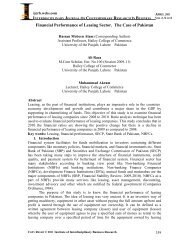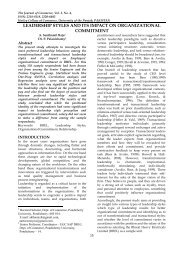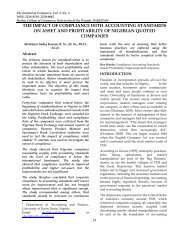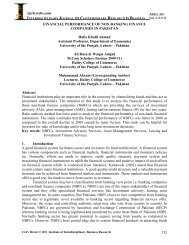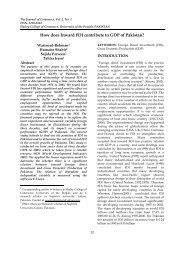women entrepreneurship in india (a case study in andhra pradesh)
women entrepreneurship in india (a case study in andhra pradesh)
women entrepreneurship in india (a case study in andhra pradesh)
You also want an ePaper? Increase the reach of your titles
YUMPU automatically turns print PDFs into web optimized ePapers that Google loves.
The Journal of Commerce, Vol. 3, No. 3<br />
ISSN: 2218-8118, 2220-6043<br />
Hailey College of Commerce, University of the Punjab, PAKISTAN<br />
WOMEN ENTREPRENEURSHIP IN INDIA (A CASE STUDY IN<br />
ANDHRA PRADESH)<br />
Dr.S.Tarakeswara Rao 1 , Prof.G.Tulasi Rao and<br />
Mr.M.P.Suri Ganesh<br />
Abstract<br />
In India, <strong>entrepreneurship</strong> among <strong>women</strong> is of<br />
recent orig<strong>in</strong>. Socio – economic background is an<br />
important factor that <strong>in</strong>fluences the woman to<br />
start their bus<strong>in</strong>ess. Money is not the sole<br />
objective among woman entrepreneurs to enter<br />
<strong>in</strong> to the bus<strong>in</strong>ess. The studies relat<strong>in</strong>g to<br />
woman entrepreneurs <strong>in</strong> rural areas further<br />
reveal that tra<strong>in</strong><strong>in</strong>g and awareness regard<strong>in</strong>g<br />
different agencies have proved beneficial for<br />
<strong>women</strong> entrepreneurs <strong>in</strong> build<strong>in</strong>g confidence.<br />
S<strong>in</strong>ce <strong>entrepreneurship</strong> development <strong>in</strong>volves<br />
provision of additional channels of funds <strong>in</strong> the<br />
form of work<strong>in</strong>g capital and credit, tra<strong>in</strong><strong>in</strong>g,<br />
management skill etc., DWCRA with an<br />
entrepreneurial development of <strong>women</strong> provides<br />
all these <strong>in</strong>puts by consider<strong>in</strong>g <strong>women</strong> as<br />
critical to development. This <strong>in</strong>tervention aims<br />
at not only rais<strong>in</strong>g the <strong>in</strong>come of rural <strong>women</strong> of<br />
poor households, but also enabl<strong>in</strong>g organized<br />
participation of groups <strong>in</strong> the programme of<br />
credit, skill tra<strong>in</strong><strong>in</strong>g and <strong>in</strong>frastructure support<br />
for self employment <strong>in</strong> groups who cannot take<br />
up economic activities, <strong>in</strong>dividually as their<br />
own.<br />
INTRODUCTION<br />
Entrepreneurship is considered as one of the<br />
most important factors contribut<strong>in</strong>g to the<br />
economic development of the society.<br />
Entrepreneurs have been considered<br />
<strong>in</strong>strumental <strong>in</strong> <strong>in</strong>itiat<strong>in</strong>g and susta<strong>in</strong><strong>in</strong>g socioeconomic<br />
development. There are evidences to<br />
believe that countries which have<br />
proportionately higher percentage of<br />
entrepreneurs <strong>in</strong> their population have<br />
developed much faster as compared to<br />
countries, which have lesser percentage of them<br />
1 Faculty Member – Dept. of Commerce & Mgt.<br />
Studies, Dr.B.R.Ambedkar University –<br />
Srikakulam- Andhra Pradesh – INDIA. Email:<br />
taraksivvala@gmail.com<br />
43<br />
<strong>in</strong> the society. They discover new sources of<br />
supply of materials and markets and establish<br />
new and more effective forms of organisation.<br />
Entrepreneurs perceive new opportunities and<br />
seize them with super normal will power and<br />
energy, essential to overcome the resistance that<br />
social environment offers 2 .<br />
Development of <strong>entrepreneurship</strong> among<br />
<strong>women</strong> is a major step to <strong>in</strong>crease <strong>women</strong><br />
participation <strong>in</strong> the process of economic<br />
development. It will speed up economic<br />
growth, and provide employment opportunities<br />
for <strong>women</strong> resulted <strong>in</strong> improv<strong>in</strong>g the economic<br />
<strong>in</strong>dependence. Provision of economic<br />
opportunities for <strong>women</strong> can also improve the<br />
social, educational and health status of <strong>women</strong><br />
and their families. In advanced countries, there<br />
is a phenomenon of <strong>in</strong>crease <strong>in</strong> the number of<br />
self – employed <strong>women</strong> after the World War II.<br />
In U.S.A, <strong>women</strong> own 25 per cent of all bus<strong>in</strong>ess,<br />
even though their sales on an average are less<br />
than two – fifths of those of other small<br />
bus<strong>in</strong>ess 3 . In Canada, one-third of small<br />
bus<strong>in</strong>ess is owned by <strong>women</strong> and <strong>in</strong> France it is<br />
one – fifth.<br />
A similar trend is noticed even among the<br />
developed nations <strong>in</strong> Asia. Women constitute<br />
40 per cent of the total workforce <strong>in</strong> these<br />
countries 5 . It has been seen that <strong>women</strong><br />
outnumber men by at least two times<br />
particularly when it comes to start<strong>in</strong>g bus<strong>in</strong>ess<br />
<strong>in</strong> Ch<strong>in</strong>a. There are over five million <strong>women</strong><br />
entrepreneurs constitut<strong>in</strong>g one-fourth of all the<br />
entrepreneurs <strong>in</strong> Ch<strong>in</strong>a 6 . In Japan to a similar<br />
trend has been noticed. Unfortunately, the trend<br />
<strong>in</strong> India does not go along the same l<strong>in</strong>es. The<br />
1991 census shows that the proportion of<br />
enterprises setup and run by <strong>women</strong> <strong>in</strong> India<br />
was approximately a fraction of one per cent 7 .<br />
The total number of <strong>women</strong> <strong>in</strong> India is a<br />
whopp<strong>in</strong>g figure of 526 million. This female<br />
population is larger than the comb<strong>in</strong>ed total<br />
populations of Canada, USA and the Russian<br />
federation. Unfortunately a very small<br />
percentage of the woman population belong<strong>in</strong>g
Women Entrepreneurship <strong>in</strong> India (A <strong>case</strong> <strong>study</strong> <strong>in</strong> Andhra Pradesh)<br />
to the elite, educated and upper – middle class<br />
especially <strong>in</strong> the cities, has been exposed to<br />
issues on Women‟s roles, career options and<br />
jobs. At the same time <strong>women</strong> are under –<br />
represented <strong>in</strong> government and decision –<br />
mak<strong>in</strong>g positions. At present, less than eight<br />
per cent of parliamentary seats, less than six per<br />
cent of cab<strong>in</strong>et positions and less than four per<br />
cent of seats <strong>in</strong> High Courts and the Supreme<br />
Court are occupied by <strong>women</strong> less than three<br />
per cent of adm<strong>in</strong>istrators and managers are<br />
<strong>women</strong>. The not – so – fortune sister of the glam<br />
doll urban and rural <strong>women</strong> consumer battle<br />
their day with <strong>in</strong>adequate wages, poverty,<br />
female feticide, sexual harassment, lack of<br />
education and job skills, HIV <strong>in</strong>fection etc.<br />
The emergence of <strong>women</strong> on the economic scene<br />
as entrepreneurs is a significant development <strong>in</strong><br />
the emancipation of <strong>women</strong> and secur<strong>in</strong>g them<br />
a place <strong>in</strong> the society, which they have all along<br />
deserved. The hidden entrepreneurial potentials<br />
of <strong>women</strong> have gradually been chang<strong>in</strong>g with<br />
the grow<strong>in</strong>g sensitivity to the role and economic<br />
status <strong>in</strong> the society. Women are <strong>in</strong>creas<strong>in</strong>gly<br />
becom<strong>in</strong>g conscious of their existence, their<br />
rights and their work situations. Today <strong>women</strong><br />
entrepreneurs represent a group of <strong>women</strong> who<br />
have broken away from the beaten track and are<br />
explor<strong>in</strong>g new avenues of economic<br />
participation. Among these reasons for <strong>women</strong><br />
to run organized enterprises are their skill and<br />
knowledge, their talents and abilities <strong>in</strong> bus<strong>in</strong>ess<br />
and a compell<strong>in</strong>g desire of want<strong>in</strong>g to do<br />
someth<strong>in</strong>g positive.<br />
What makes their arrival as well as<br />
achievements even more significant and<br />
commendable are the struggles they have to put<br />
up, frustrations they have to experience and the<br />
multiple handicaps they have to overcome to<br />
emerge as entrepreneurs at the early stage and<br />
subsequently achiev<strong>in</strong>g success <strong>in</strong> bus<strong>in</strong>ess at<br />
the stage of manag<strong>in</strong>g their enterprises.<br />
Status of <strong>women</strong> freedom depends on economic<br />
conditions even more than political. If a woman<br />
is not economically free and self-earn<strong>in</strong>g, she<br />
will have to depend on her husband or someone<br />
else, and dependents are never free. These were<br />
the ideas of Pandit Jawaharlal Nehru, the first<br />
Prime M<strong>in</strong>ister of India, who vividly<br />
highlighted the importance of economic<br />
44<br />
<strong>in</strong>dependence of <strong>women</strong>. These views are<br />
antagonistic to the laws of Manu written early <strong>in</strong><br />
the Christian era which stress the need to<br />
control <strong>women</strong> because of the „evils „ of female<br />
character. The follow<strong>in</strong>g l<strong>in</strong>es reflect the age-old<br />
idea of keep<strong>in</strong>g <strong>women</strong> dependent.<br />
A woman is never <strong>in</strong>dependent. In childhood a<br />
female must be subjected to her father, <strong>in</strong> youth<br />
to her husband, when her lord is dead to her<br />
sons. A woman must never be <strong>in</strong>dependent.<br />
Women are often described as the better half of<br />
man. But the actual condition of <strong>women</strong> <strong>in</strong> the<br />
world does not tally with this description. In no<br />
country have <strong>women</strong> achieved equality with<br />
men. Of the world‟s 1.4 billion poor people it is<br />
estimated that nearly 70 per cent are <strong>women</strong>.<br />
Between 75 and 80 per cent of the world‟s 30<br />
million refugees are <strong>women</strong> and children.<br />
Educational backwardness is a major reason of<br />
<strong>women</strong> lagg<strong>in</strong>g beh<strong>in</strong>d men. Of the world‟s one<br />
billion illiterate adults, two thirds are <strong>women</strong>.<br />
Two-thirds of the 150 million children<br />
worldwide who are not <strong>in</strong> schools are girls. 8<br />
On the other hand history also records that<br />
<strong>women</strong> <strong>in</strong> Vedic age have played an important<br />
part <strong>in</strong> religious and social functions. The<br />
position of wife was an honored one as no<br />
religious ceremony could be performed by the<br />
husband alone. The third millennium B.C.<br />
Harappan and Mohanjodoro culture <strong>in</strong>dicates<br />
that Indian <strong>women</strong> enjoyed a comparatively<br />
high status, which surpassed that of<br />
contemporary civilizations <strong>in</strong> ancient areas,<br />
Mesopotamia or Egypt. The Rugveda too<br />
provides evidence to prove the concept of<br />
equality of <strong>women</strong> with men as regards the<br />
access to knowledge, even to the knowledge of<br />
the absolute. There have always been<br />
outstand<strong>in</strong>g <strong>women</strong> who have risen alone<br />
despite the constra<strong>in</strong>ts of their time.<br />
Unfortunately, due to social, economic and<br />
political changes later on <strong>women</strong> lost their<br />
position <strong>in</strong> education and other fields.<br />
Economically <strong>women</strong> became completely<br />
dependent on men. 9<br />
Although a lot has been done to ameliorate the<br />
condition of womank<strong>in</strong>d, “International<br />
Women‟s Day”, which falls on March 8, rem<strong>in</strong>ds<br />
us every year that much more needs to be done<br />
to ensure a better deal for the female half of the
The Journal of Commerce, Vol. 3, No. 3<br />
ISSN: 2218-8118, 2220-6043<br />
Hailey College of Commerce, University of the Punjab, PAKISTAN<br />
humanist. The fourth world conference on<br />
<strong>women</strong> held <strong>in</strong> Beij<strong>in</strong>g <strong>in</strong> 1995, resulted <strong>in</strong><br />
agreement by 189 delegations on a five year plan<br />
to enhance the social, economic and political<br />
empowerment of <strong>women</strong>, improve their health,<br />
advance their education and promote their<br />
reproductive rights. Over 100 countries have<br />
announced new <strong>in</strong>itiatives to further the<br />
advancement of <strong>women</strong> as a result of Beij<strong>in</strong>g<br />
conference. The 1979 UN convention on the<br />
elim<strong>in</strong>ation of all forms of discrim<strong>in</strong>ation<br />
amongst <strong>women</strong>, often described as the bill of<br />
rights for <strong>women</strong>, has now been ratified by 154<br />
countries.<br />
“When <strong>women</strong> move forward, the families<br />
moves, the village moves”. These words of<br />
Pandit Jawaharlal Nehru are often repeated<br />
because it is an accepted fact that only when the<br />
<strong>women</strong> are <strong>in</strong> the ma<strong>in</strong>stream of progress can<br />
any economic and social development be<br />
mean<strong>in</strong>gful.<br />
In India from the very beg<strong>in</strong>n<strong>in</strong>g, <strong>women</strong> have<br />
been managers of the kitchen and have solely<br />
dom<strong>in</strong>ated the area of household activities. So<br />
deep has been the impact of this, that the<br />
general attitude of the people about <strong>women</strong><br />
entrepreneurs is that they are makers of pickles,<br />
papads, masalas, and other household goods.<br />
Today non – traditional enterprises are easily<br />
managed by <strong>women</strong> and are done so excellently<br />
with them as the decision – makers. They are<br />
flourish<strong>in</strong>g well as lead<strong>in</strong>g consultants,<br />
publishers, exporters of mach<strong>in</strong>ery,<br />
manufactures of electric goods, exporters of<br />
garments, designers, <strong>in</strong>terior decorators and the<br />
like.<br />
The hidden entrepreneurial potentials of <strong>women</strong><br />
have gradually been chang<strong>in</strong>g with the grow<strong>in</strong>g<br />
sensitivity to the role and economic status <strong>in</strong><br />
society. Women are <strong>in</strong>creas<strong>in</strong>gly be<strong>in</strong>g conscious<br />
of their existence, their rights and their work<br />
situation. And yet the middle class strata<br />
<strong>women</strong> have accepted their role and are not<br />
ready to alter for fear of a social backlash.<br />
Today, woman entrepreneurs represent a group<br />
of <strong>women</strong> who have broken away from the<br />
beaten track and are explor<strong>in</strong>g new avenues of<br />
economic participation. Among the reasons for<br />
<strong>women</strong> to run organized enterprises are their<br />
45<br />
skill and knowledge, their talents and abilities <strong>in</strong><br />
bus<strong>in</strong>ess and a compell<strong>in</strong>g desire of want<strong>in</strong>g to<br />
do someth<strong>in</strong>g positive.<br />
Over the last few decades, while <strong>women</strong> have<br />
come forward to establish their own enterprises,<br />
their numbers rema<strong>in</strong> few and far between. The<br />
entrepreneurial world is still male dom<strong>in</strong>ated. In<br />
developed countries <strong>women</strong> tend to perform<br />
secretarial or low-level managerial jobs <strong>in</strong> the<br />
corporate sectors – <strong>in</strong>deed, less than five per<br />
cent of senior management portions are held by<br />
<strong>women</strong> <strong>in</strong> the USA. In develop<strong>in</strong>g countries<br />
such as India even <strong>in</strong> the small-scale sector, less<br />
than seven per cent of the enterprises have been<br />
set – up by <strong>women</strong>. But probably what is<br />
noteworthy is that <strong>women</strong> have plunged <strong>in</strong>to<br />
the field of <strong>entrepreneurship</strong> and have been<br />
found effective <strong>in</strong> emerg<strong>in</strong>g social, economical<br />
role. Women had been a manager s<strong>in</strong>ce long,<br />
from the time the concept of liv<strong>in</strong>g <strong>in</strong> a family<br />
emerged. She had been an entrepreneur with<strong>in</strong><br />
the four walls where she was <strong>in</strong>novative <strong>in</strong><br />
terms of budget<strong>in</strong>g with the limited <strong>in</strong>come<br />
resources used the waste material for mak<strong>in</strong>g<br />
some useful products. With the chang<strong>in</strong>g role<br />
that <strong>women</strong> accepted ever s<strong>in</strong>ce mid- eighties,<br />
the role of <strong>entrepreneurship</strong> amongst <strong>women</strong><br />
has ga<strong>in</strong>ed a considerable importance.<br />
The 1991 Industrial Policy has envisaged special<br />
tra<strong>in</strong><strong>in</strong>g programmes to support <strong>women</strong><br />
entrepreneurs. Accord<strong>in</strong>gly <strong>women</strong><br />
entrepreneurs are receiv<strong>in</strong>g tra<strong>in</strong><strong>in</strong>g through<br />
Entrepreneurship Development Programmes<br />
(EDPS) conducted by various <strong>in</strong>stitutions and<br />
organizations both at central and state levels.<br />
The Small Industries Development Organisation<br />
(SIDO), with its field offices all over the country<br />
has been carry<strong>in</strong>g out development programmes<br />
for <strong>women</strong> entrepreneurs and is provid<strong>in</strong>g<br />
technical schemes for sett<strong>in</strong>g up of SSI units. In<br />
view of the chang<strong>in</strong>g outlook for the promotion<br />
of <strong>women</strong> enterprises, the SSI Board <strong>in</strong> 1991<br />
revised the def<strong>in</strong>ition of <strong>women</strong> enterprises by<br />
omitt<strong>in</strong>g the condition of employ<strong>in</strong>g 50 per cent<br />
of <strong>women</strong> workers. This provided a boost to<br />
<strong>women</strong> entrepreneurs to take up bus<strong>in</strong>ess and<br />
avail all facilities / concessions as are applicable<br />
to a SSIs.
Women Entrepreneurship <strong>in</strong> India (A <strong>case</strong> <strong>study</strong> <strong>in</strong> Andhra Pradesh)<br />
“Women <strong>in</strong> bus<strong>in</strong>ess” is considered a recent<br />
phenomenon <strong>in</strong> India. The fact that almost half<br />
the population of this large country comprises of<br />
females while bus<strong>in</strong>esses owned and operated<br />
by them constitute less than five per cent is a<br />
reflection on social, cultural as well as economic<br />
distractions <strong>in</strong> the decades of development. 12<br />
Indeed, <strong>women</strong>‟s participation <strong>in</strong> economic<br />
activity and production of goods and services is<br />
far greater than formal statistics might reveal,<br />
s<strong>in</strong>ce much of it takes place <strong>in</strong> the <strong>in</strong>formal<br />
sector as also <strong>in</strong> the households.<br />
As education spread and compulsions for<br />
earn<strong>in</strong>g have grown more and more <strong>women</strong><br />
have started to go out of the homes and opt<br />
either for wage employment or self employment<br />
/ entrepreneurial career. In <strong>case</strong> of woman,<br />
however, handicaps to entry <strong>in</strong>to bus<strong>in</strong>ess<br />
ownership have been for too many given the<br />
traditional, conservative, orthodox Indian<br />
society. The process of break<strong>in</strong>g many of these<br />
shackles has been rather slow. However,<br />
changes have started tak<strong>in</strong>g place as far as role<br />
of <strong>women</strong> <strong>in</strong> economic development is<br />
concerned and strides have been made by<br />
<strong>women</strong> <strong>in</strong> sett<strong>in</strong>g up and manag<strong>in</strong>g bus<strong>in</strong>ess; a<br />
fairly large number has „graduated‟ out of the<br />
<strong>in</strong>itial phase of go<strong>in</strong>g out of the home to work<br />
for somebody. Employment to self –<br />
employment has been a employment has been a<br />
noticeable phenomenon <strong>in</strong> the emergence of<br />
new <strong>women</strong> entrepreneurs. Many of them not<br />
only own small bus<strong>in</strong>ess but have set up and<br />
run manufactur<strong>in</strong>g enterprises. Which is<br />
ultimate <strong>in</strong> the <strong>entrepreneurship</strong> movement.<br />
And by do<strong>in</strong>g so successfully, they have<br />
unquestionably established the fact that <strong>women</strong><br />
can be as capable and successful entrepreneurs<br />
as men <strong>in</strong> bus<strong>in</strong>ess and <strong>in</strong>dustry.<br />
And yet, the society at large cont<strong>in</strong>ues to suffer<br />
from a various misconceptions (myths)<br />
apprehensions and suspicions about <strong>women</strong><br />
entrepreneurs <strong>in</strong> bus<strong>in</strong>ess and <strong>in</strong>dustry. This is<br />
the result of <strong>in</strong>adequacies of literature about<br />
Indian <strong>women</strong> <strong>in</strong> bus<strong>in</strong>ess and <strong>in</strong>dustry. The<br />
dearth of documentation, <strong>in</strong>formation and<br />
publications about <strong>women</strong> entrepreneurs has<br />
allowed a stereo type image of <strong>women</strong> <strong>in</strong><br />
bus<strong>in</strong>ess to persist. Typically <strong>women</strong> have been<br />
portrayed as those undertak<strong>in</strong>g bus<strong>in</strong>ess of<br />
predictable l<strong>in</strong>es – the papad – pickle<br />
manufactur<strong>in</strong>g, knitt<strong>in</strong>g and tailor<strong>in</strong>g,<br />
readymade garments, herbal, medic<strong>in</strong>es<br />
manufactur<strong>in</strong>g, etc. Indeed, a large number of<br />
Indian <strong>women</strong> are engaged <strong>in</strong> such<br />
supplementary <strong>in</strong>come generat<strong>in</strong>g activities. The<br />
base of most such activities has been „home‟ and<br />
those have been direct or <strong>in</strong>direct extensions of<br />
the usual household chores of an Indian woman,<br />
someth<strong>in</strong>g a woman is good at <strong>in</strong> the kitchen or<br />
as a housewife.<br />
But despite these numerous barriers and<br />
tangible obstacles <strong>women</strong> are, enter<strong>in</strong>g <strong>in</strong> to the<br />
field of bus<strong>in</strong>ess <strong>in</strong> <strong>in</strong>creas<strong>in</strong>g numbers. What<br />
makes their arrival as well as achievements even<br />
more significant and commendable are the<br />
struggles they have to put up, frustration they<br />
have to survive and the multiple handicaps they<br />
have to overcome to emerge as entrepreneurs at<br />
the entry stage and subsequently achiev<strong>in</strong>g<br />
success <strong>in</strong> bus<strong>in</strong>ess at the stage of manag<strong>in</strong>g<br />
their enterprises.<br />
The <strong>women</strong> entrepreneur of today is neither a<br />
rare orchid nor a voiceless hero<strong>in</strong>e with<br />
playback support rather she embodies a<br />
compell<strong>in</strong>g urge for self-expression, which<br />
needs encouragement from everyone concerned<br />
with the progress of the nation.<br />
STUDIES CONDUCTED AT<br />
NATIONAL AND INTERNATIONAL<br />
LEVEL<br />
Studies conducted <strong>in</strong> Poland highlights that<br />
<strong>women</strong> entrepreneurs are <strong>in</strong>volved <strong>in</strong><br />
traditional and non-traditional bus<strong>in</strong>ess.<br />
However they are successful because of the<br />
formal tra<strong>in</strong><strong>in</strong>g they took before the start of the<br />
bus<strong>in</strong>ess. In Jamaica, <strong>women</strong> have been<br />
<strong>in</strong>volved <strong>in</strong> areas, which require less capital and<br />
extension of household activities. Household<br />
responsibility plays a significant role <strong>in</strong> choice of<br />
economic activity. Comparative studies of<br />
<strong>women</strong> <strong>entrepreneurship</strong> <strong>in</strong> India and U.K.<br />
reveals that the share of <strong>women</strong> entrepreneur <strong>in</strong><br />
bus<strong>in</strong>ess is relatively more <strong>in</strong> U.K. than <strong>in</strong> India<br />
s<strong>in</strong>ce better facilities are available to <strong>women</strong> <strong>in</strong><br />
U.K. In both the countries family responsibility<br />
is the ma<strong>in</strong> concern faced by them.<br />
46
The Journal of Commerce, Vol. 3, No. 3<br />
ISSN: 2218-8118, 2220-6043<br />
Hailey College of Commerce, University of the Punjab, PAKISTAN<br />
Woman enterprise<br />
A woman entrepreneur is an adult who owns<br />
and runs an enterprise, especially a commercial<br />
one, often at personal f<strong>in</strong>ancial risk. A recent<br />
ILO-Indian <strong>study</strong> of woman entrepreneurs gave<br />
the def<strong>in</strong>ition of <strong>women</strong>‟s enterprise as „a small<br />
unit where one or more <strong>women</strong> entrepreneurs<br />
have not less than 50 per cent f<strong>in</strong>ancial<br />
hold<strong>in</strong>gs. 13<br />
The concept of <strong>women</strong> <strong>entrepreneurship</strong> is<br />
becom<strong>in</strong>g a global phenomenon play<strong>in</strong>g a vital<br />
role <strong>in</strong> the bus<strong>in</strong>ess community. In India <strong>women</strong><br />
have made a comparatively late entry <strong>in</strong>to<br />
bus<strong>in</strong>ess scenario ma<strong>in</strong>ly due to the orthodox<br />
and traditional socio-cultural environment.<br />
Although <strong>women</strong> face various problems <strong>in</strong> the<br />
process of establish<strong>in</strong>g, develop<strong>in</strong>g and runn<strong>in</strong>g<br />
their enterprise, nevertheless, their scope of<br />
development is very high <strong>in</strong> India, especially <strong>in</strong><br />
rural areas with more <strong>women</strong> mak<strong>in</strong>g<br />
development – oriented programme viz.<br />
Development of Women and Children <strong>in</strong> Rural<br />
Areas, (DWCRA) launched <strong>in</strong> and be<strong>in</strong>g<br />
implemented <strong>in</strong> 1982-83. In what follows, an<br />
attempt is made to analyze the success of such a<br />
scheme <strong>in</strong> terms of its survival, growth and<br />
development of <strong>women</strong> entrepreneurs and<br />
identify the problems faced by the <strong>women</strong><br />
entrepreneurs.<br />
Woman Entrepreneurship <strong>in</strong> India<br />
Around 50 per cent of India‟s population is<br />
<strong>women</strong>. Yet, bus<strong>in</strong>ess spheres such as trade,<br />
commerce and <strong>in</strong>dustry, is still considered a<br />
male preserve. Entrepreneurial work has also<br />
been a predom<strong>in</strong>antly a man‟s world <strong>in</strong> India.<br />
This is based on the fact that only seven per cent<br />
of the total entrepreneurs <strong>in</strong> India are <strong>women</strong>.<br />
Indian <strong>women</strong> are <strong>in</strong> no way <strong>in</strong>ferior to men <strong>in</strong><br />
all walks of life and they can be as good<br />
entrepreneurs as men <strong>in</strong> the country. Therefore,<br />
it is essential to exploit the potentials of Indian<br />
<strong>women</strong>. Women‟s participation <strong>in</strong> trade,<br />
<strong>in</strong>dustry and commerce, requir<strong>in</strong>g<br />
<strong>entrepreneurship</strong>, is still poor ma<strong>in</strong>ly because of<br />
the problems associated with their gender roles.<br />
Therefore, promotion of <strong>entrepreneurship</strong> and<br />
economic empowerment of <strong>women</strong> poses a<br />
47<br />
challenge to the government, fund<strong>in</strong>g agencies<br />
and non-government organisations. It is<br />
important for these people to focus on the<br />
limitations faced by the <strong>women</strong> and to plan<br />
support<strong>in</strong>g systems to enhance the <strong>women</strong><br />
<strong>entrepreneurship</strong> <strong>in</strong> India.<br />
Need and importance of <strong>women</strong><br />
entrepreneurs<br />
It is imperative to note the participation of<br />
<strong>women</strong> <strong>in</strong> economic activities as self-employed<br />
<strong>in</strong>dividuals. Many of the traditional occupations<br />
open to <strong>women</strong> were ma<strong>in</strong>ly based on caste,<br />
creed and the nature of self-employment based<br />
on the standard of liv<strong>in</strong>g. Presently, <strong>women</strong> are<br />
generat<strong>in</strong>g employment for themselves <strong>in</strong> an<br />
unorganized sector and another category of<br />
<strong>women</strong> who provide employment for others.<br />
The country needs to mobilize and utilize fully<br />
all its resources <strong>in</strong>clud<strong>in</strong>g human resources. The<br />
participation of <strong>women</strong> <strong>in</strong> economic activities is<br />
necessary not only from a human resource po<strong>in</strong>t<br />
of view but also is essential even from the<br />
objective of rais<strong>in</strong>g the status of <strong>women</strong> <strong>in</strong> the<br />
society. The economic status of the <strong>women</strong> is<br />
now accepted as an <strong>in</strong>dicator of a society‟s stage<br />
of development and therefore it becomes<br />
imperative for the government to frame policies<br />
for development of <strong>entrepreneurship</strong> among<br />
<strong>women</strong>. The long-term objectives of the<br />
development programmes for <strong>women</strong> should<br />
aim to raise their economic and social status <strong>in</strong><br />
order to br<strong>in</strong>g them <strong>in</strong>to the ma<strong>in</strong>stream of<br />
national life and development. For this, due<br />
recognition has to be accorded to the role and<br />
contribution of <strong>women</strong> <strong>in</strong> the various social<br />
economic and political and cultural activities.<br />
Factors <strong>in</strong>fluenc<strong>in</strong>g <strong>women</strong><br />
entrepreneurs<br />
The follow<strong>in</strong>g are the major factors <strong>in</strong>fluenc<strong>in</strong>g<br />
the <strong>women</strong> entrepreneur.<br />
Economic <strong>in</strong>dependence.<br />
Establish<strong>in</strong>g their own creative idea.<br />
Establish<strong>in</strong>g their own identity.<br />
Achievement of excellence.<br />
Build<strong>in</strong>g confidence.<br />
Develop<strong>in</strong>g risk-tak<strong>in</strong>g ability.
Women Entrepreneurship <strong>in</strong> India (A <strong>case</strong> <strong>study</strong> <strong>in</strong> Andhra Pradesh)<br />
<br />
<br />
<br />
Motivation.<br />
Equal status <strong>in</strong> society.<br />
Greater freedom and mobility<br />
The concept of develop<strong>in</strong>g <strong>women</strong><br />
<strong>entrepreneurship</strong> lays emphasis of the<br />
productive utilization of <strong>women</strong> labour force to<br />
generate <strong>in</strong>come and output. The programme<br />
for develop<strong>in</strong>g <strong>women</strong> entrepreneur would<br />
make a dent to alleviate poverty. The Sixth Five<br />
Year Plan for the first time highlighted the<br />
problem of <strong>women</strong> <strong>in</strong>tegration <strong>in</strong> economic<br />
development <strong>in</strong> India and emphasized need to<br />
expand <strong>women</strong> employment <strong>in</strong> the household<br />
sector by provid<strong>in</strong>g adequate support <strong>in</strong> the<br />
areas of technology upgradation, tra<strong>in</strong><strong>in</strong>g,<br />
credit, raw material requirements and<br />
development of f<strong>in</strong>anc<strong>in</strong>g loans. For this<br />
purpose, s<strong>in</strong>cere efforts have been taken under<br />
various plans, policies, programmes for the<br />
development of <strong>women</strong> <strong>entrepreneurship</strong> s<strong>in</strong>ce<br />
1990‟s.<br />
The DWCRA groups (also known as SHGs) is<br />
considered as a viable organisation of the rural<br />
poor particularly <strong>women</strong> for deliver<strong>in</strong>g micro<br />
credit <strong>in</strong> order to undertake entrepreneurial<br />
activities. Some of the studies on these groups<br />
particularly those managed by <strong>women</strong><br />
successfully demonstrated how to mobilize and<br />
manage thrift activities, appraise credit needs,<br />
enforce f<strong>in</strong>ancial discipl<strong>in</strong>e, ma<strong>in</strong>ta<strong>in</strong> credit<br />
l<strong>in</strong>kages with banks and effectively undertake<br />
<strong>in</strong>come generat<strong>in</strong>g activities etc. 16 These studies<br />
also showed that the poor as a group are quite<br />
creditworthy and repayment of loan is quite<br />
satisfactory.<br />
Women Entrepreneurship <strong>in</strong> AP: A<br />
<strong>case</strong> SHGs<br />
The scheme, Development of Women and<br />
Children <strong>in</strong> Rural Areas (DWCRA) launched <strong>in</strong><br />
1982-83 (presently called as SHGs), <strong>in</strong>augurated<br />
an era for systematically organiz<strong>in</strong>g <strong>women</strong> <strong>in</strong><br />
groups for provid<strong>in</strong>g them opportunities of selfemployment<br />
on a susta<strong>in</strong>ed basis. Several<br />
thousands of rural <strong>women</strong> from the length and<br />
breadth of the country participate <strong>in</strong> this<br />
programme and they have taken up a number of<br />
trades under DWCRA banner.<br />
48<br />
S<strong>in</strong>ce <strong>entrepreneurship</strong> development <strong>in</strong>volves<br />
provision of additional channels of funds <strong>in</strong> the<br />
form of work<strong>in</strong>g capital and credit, tra<strong>in</strong><strong>in</strong>g,<br />
management skill etc., DWCRA with an<br />
entrepreneurial development of <strong>women</strong><br />
provides all these <strong>in</strong>puts by consider<strong>in</strong>g <strong>women</strong><br />
as critical to development. This <strong>in</strong>tervention<br />
aims at not only rais<strong>in</strong>g the <strong>in</strong>come of rural<br />
<strong>women</strong> of poor households, but also enabl<strong>in</strong>g<br />
organized participation of groups <strong>in</strong> the<br />
programme of credit, skill tra<strong>in</strong><strong>in</strong>g and<br />
<strong>in</strong>frastructure support for self employment <strong>in</strong><br />
groups who cannot take up economic activities,<br />
<strong>in</strong>dividually as their own.<br />
CONCLUSION<br />
The ma<strong>in</strong> objective of the scheme is to improve<br />
the economic, health, educational and social<br />
status of rural <strong>women</strong> by provid<strong>in</strong>g them<br />
assistance and creat<strong>in</strong>g employment<br />
opportunities. The specific objectives of the<br />
scheme are:<br />
1. To help and promote self-employment<br />
among the rural <strong>women</strong>, who are below<br />
the poverty l<strong>in</strong>e, by provid<strong>in</strong>g skill<br />
tra<strong>in</strong><strong>in</strong>g <strong>in</strong> vocations which are<br />
acceptable to the beneficiaries, by<br />
encourag<strong>in</strong>g productivity <strong>in</strong> their<br />
exist<strong>in</strong>g vocations and by <strong>in</strong>troduc<strong>in</strong>g<br />
new activities hitherto undertaken;<br />
2. To organize the beneficiaries <strong>in</strong> groups,<br />
activity-wise and promote economic<br />
and social self-reliance.<br />
3. To generate <strong>in</strong>come for the rural poor<br />
by creat<strong>in</strong>g avenues for production of<br />
goods and services;<br />
4. To organize production enhanc<strong>in</strong>g<br />
programmes <strong>in</strong> rural areas; and<br />
5. To provide for care of the children of<br />
the work<strong>in</strong>g<strong>women</strong> by provid<strong>in</strong>g an<br />
improved environment, care and food<br />
by establish<strong>in</strong>g crèches / balwadis.<br />
The programme called for formation of groups<br />
of 10-15 <strong>women</strong> who could collectively engage<br />
<strong>in</strong> an activity. One woman amongst the<br />
members functions as the group organizer who<br />
helps <strong>in</strong> the choice of activity, procurement of<br />
raw materials, market<strong>in</strong>g of products etc.<br />
A revolv<strong>in</strong>g fund of Rs. 15,000/- (subsequently<br />
<strong>in</strong>creased to Rs.20, 000/-) was made available to
The Journal of Commerce, Vol. 3, No. 3<br />
ISSN: 2218-8118, 2220-6043<br />
Hailey College of Commerce, University of the Punjab, PAKISTAN<br />
each group for credit and adm<strong>in</strong>istrative needs.<br />
The programme is implemented by the District<br />
Rural Development Agency (DRDA) at the<br />
district level. SHG is the only programme of its<br />
k<strong>in</strong>d, which aims at empower<strong>in</strong>g the rural poor<br />
<strong>women</strong> by <strong>in</strong>culcat<strong>in</strong>g entrepreneurial skill. It<br />
seeks to encourage collective action <strong>in</strong> the form<br />
of group activities, which are known to work<br />
better than <strong>in</strong>dividual efforts.<br />
N. Rajendran, OP. Cit. P – 40.<br />
Kumar K.P. “Role of SHG‟s <strong>in</strong> promot<strong>in</strong>g<br />
Micro Enterprises through Micro<br />
Credit: An empirical <strong>study</strong>” Journal of<br />
Rural Development Vol.21 (2) P 232.<br />
Manimekalai and Rajeswari: 2000; Myrada:<br />
1995; NABARD; 1989; and D<strong>in</strong>akar Rao<br />
1992.<br />
Self-employment is emerg<strong>in</strong>g to be a very<br />
important source of livelihood for <strong>women</strong> <strong>in</strong><br />
Asia and South East Asia. This is due to paucity<br />
of employment opportunities. There is an<br />
additional factor that many types of paid<br />
employment are felt to be more suitable to males<br />
than females.<br />
REFERENCES<br />
Anil Kumar, “Women Entrepreneurs Profile<br />
of the Ground relatives”, SEDME Vol.<br />
30 No. 4 December 2003 P – 1.<br />
S.K. Dhameja, “Women Entrepreneurs:<br />
Opportunities, Performance, Problems<br />
Deep Publications Pvt., Ltd., New<br />
Delhi, P – 9.<br />
Anil Kumar, F<strong>in</strong>anc<strong>in</strong>g Pattern of<br />
Enterprises owned by <strong>women</strong><br />
Entrepreneurs. The Indian journal of<br />
Commerce, Vol. 57 No.2, April – June.<br />
2004. P-73.<br />
Bhandari, Arivid: Women Deserve a Better.<br />
The Tribune March 8 th 2000.<br />
Dhameeja S.K. Women Entrepreneurs;<br />
Opportunities, Performance, Problems,<br />
Deep Publications (P) Ltd., New Delhi,<br />
P – 11.<br />
Women Entrepreneurs, SIDBI Report on<br />
Small Scale Industries, OP Cit.<br />
Kanitkar, Ajit and Contractor, Nal<strong>in</strong>ee: <strong>in</strong><br />
Search of Felentity the <strong>women</strong><br />
entrepreneurs of India.<br />
Entrepreneurship Development<br />
Institute of India, Ahemedabad, 1992.<br />
Mohhicedd<strong>in</strong>. A. (1996). “Entrepreneur –<br />
Factors Affect<strong>in</strong>g Women<br />
Entrepreneurship <strong>in</strong> Small and Cottage<br />
Industries <strong>in</strong> India”. (ILO /SIDA)<br />
N.Rajendran, “Problems and Prospects of<br />
Woman Entrepreneurs”, SEDME,<br />
Vol.30, No.4 December, 2003, P – 39.<br />
49



